-
1 of 253523 objects
George Gordon Byron, 6th Baron Byron (1788-1824) signed and dated 1817
Marble | 60.0 x 29.3 x 22.2 cm (whole object) | RCIN 35425
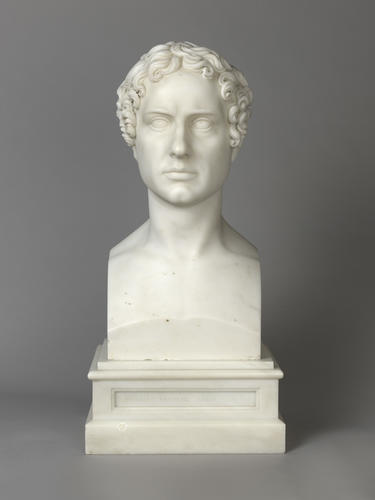
Bertel Thorvaldsen (1770-1844)
George Gordon Byron, 6th Baron Byron (1788-1824) signed and dated 1817
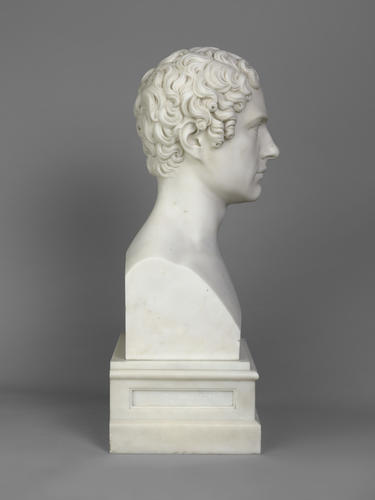
Bertel Thorvaldsen (1770-1844)
George Gordon Byron, 6th Baron Byron (1788-1824) signed and dated 1817
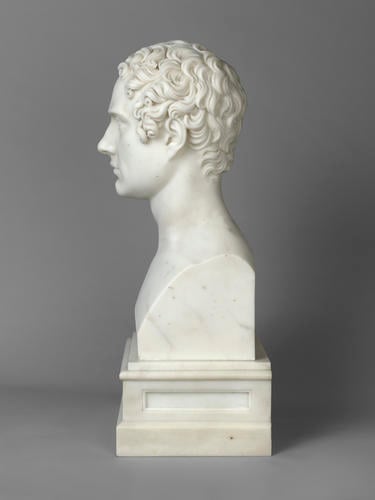
Bertel Thorvaldsen (1770-1844)
George Gordon Byron, 6th Baron Byron (1788-1824) signed and dated 1817
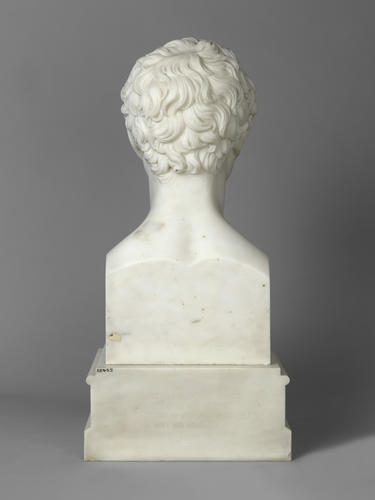
Bertel Thorvaldsen (1770-1844)
George Gordon Byron, 6th Baron Byron (1788-1824) signed and dated 1817




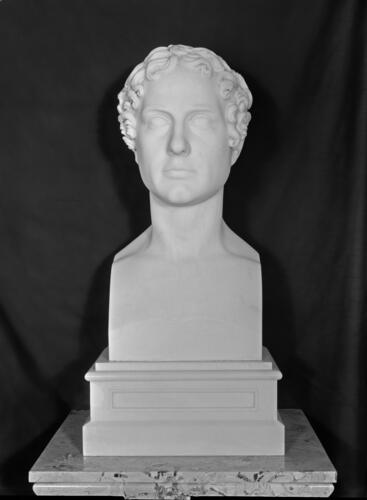
-
A life-size, head and collar, white marble bust of Lord Byron. The head is held upright and faces straight forward. The hair is arranged in stylised curls. The pupils are incised to indicate an upward gaze. The vertical side truncations occur high on the shoulder, and the vertical front truncation forms a gentle arc across the chest. Mounted on a rectangular plinth moulded at top and bottom and with a sunk tablet at the front and sides. Incised on the front of the plinth: GEORGE GORDON. LORD BYRON / B. THORBALDSEN / ROM 1817; on the back: BEQUEATHED TO KING GEORGE V. 1914 / BY CHARLOTTE LADY DORCHESTER / DAUGHTER OF LORD HOBHOUSE FOR WHOM / THE BUST WAS MODELLED.
The bust was commissioned by John Cam Hobhouse, Byron’s contemporary at Cambridge, his lifelong friend and travelling companion, and best man at the poet’s wedding in 1815. The portrait was begun in Rome in the spring of 1817. Hobhouse had written to Bertel Thorvaldsen, by now established as the leading sculptor (with the largest workshop) in the city, to ask him to make a bust of Byron.
The resulting work is a very faithful portrait, with well-known aspects of the poet’s features clearly delineated – the slightly heavy nose, the cleft in the chin and particularly the lack of earlobes – while the upward gaze of the pupils characterizes the sitter as a man inspired. Byron had been reluctant to sit for a marble bust; ‘everybody sits for their picture’, he noted later, ‘but a bust looks like putting up pretensions to permanency.’ He was especially averse to Hobhouse’s suggestion, made to Thorvaldsen at the modelling stage following the sittings, that he should include a laurel garland: ‘I won’t have my head garnished like a Christmas pie with holly – or a cod’s head and fennel.'
The completed bust arrived in London by November 1821 - a delay of several years which caused Byron much annoyance.
There are several examples of a variant of the bust in classical drapery, on a turned socle (Thorvaldsen’s Museum, Copenhagen; the Museum of Fine Arts, Boston; Chatsworth). The likeness also formed the basis for Thorvaldsen’s seated statue of Byron (1829), intended for Poet’s Corner in Westminster Abbey but (following its exclusion by the Abbey authorities) eventually erected in the Library of Trinity College, Cambridge.
The bust was bequeathed to King George V together with the equally well-known painting of the poet by George Sanders, by Lady Dorchester, Hobhouse’s daughter and the editor of his Recollections.
Text adapted from Sculpture in the Collection of His Majesty The King (2025)Provenance
Commissioned by John Cam Hobhouse (1786–1869), later 1st Baron Broughton de Gyfford; his daughter Charlotte Hobhouse Carleton, Lady Dorchester (1831–1914), by whom bequeathed to King George V in 1914; placed in the Grand Corridor at Windsor Castle.
-
Creator(s)
(nationality)Acquirer(s)
-
Medium and techniques
Marble
Measurements
60.0 x 29.3 x 22.2 cm (whole object)
Category
Object type(s)